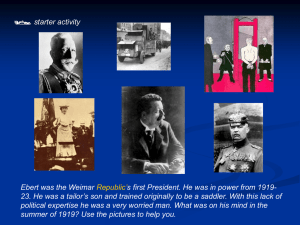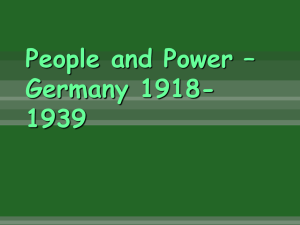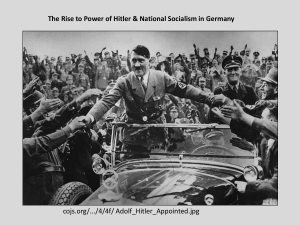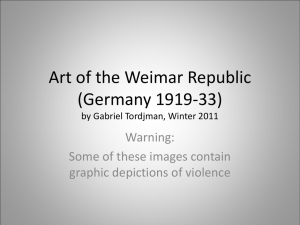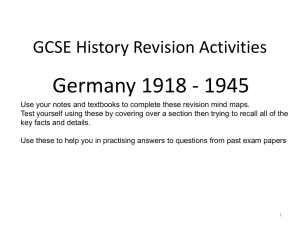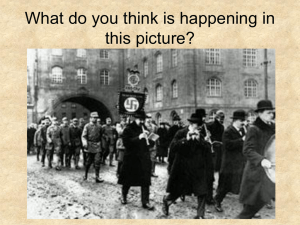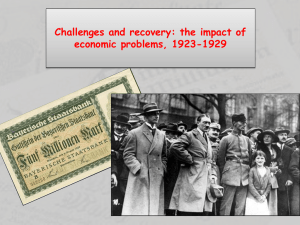Treaty of Versailles
advertisement
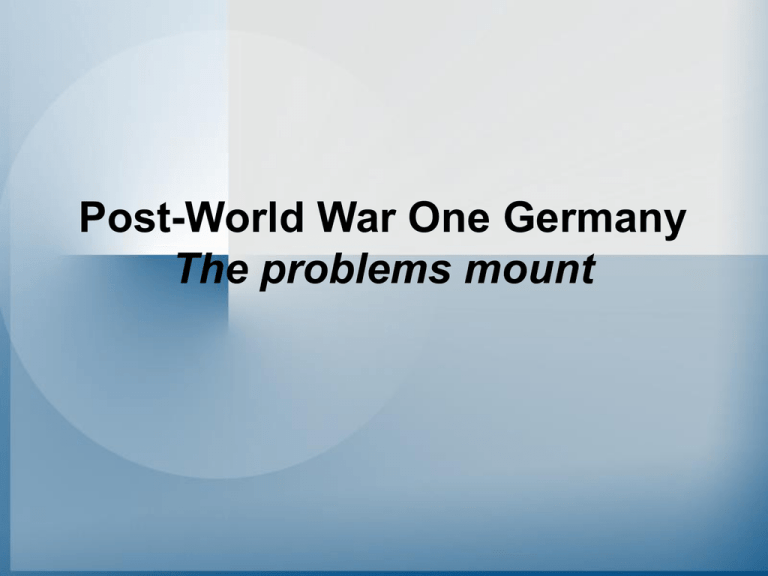
Post-World War One Germany The problems mount What was Pre-WW1 Germany like? What was Pre-WW1 Germany like? How did the First World War End? Think of at least 10 problems facing Germany at the start of 1919? Problems Facing Germany in 1918/9 Problems facing Germany • Casualties – Wounded – Dead • Collapse in Morale • Threat of Communism – Revolutions in Bavaria – Spartacist Revolt • Occupation – Allied soldiers on German soil • Unease at future – Armistice only – no terms of surrender finalised • Pariah State – No friends • Political Chaos – Kaiser into Exile – Two new governments declared • Exhausted nation – Country Broke – Blockade • Law and Order! – No military or police • Inflation – Prices rising • Unemployment – Returning soldiers – Armaments factories no longer required The Weimar Republic Is it surprising that the Weimar Republic had problems? • Why was the new government called the Weimar Government. • It had many problems already and there were many new problems on the way! • What is surprising is that the Weimar Government lasted longer than the Nazi Regime did. – Compare their lengths in charge. • Look at page 6 and write down at least 5 features of the new Weimar Constitution. Identify Problems? Fundamental Weaknesses of the Weimar Republic Advantages to State Coalition Government Pure Proportional Representation Freedom of Speech Article 48 Disadvantages to State Feature of Weimar Constitution Advantages Problems Treaty of Versailles (The Dictated Peace) General Clauses • There were a total of 440 clauses in the final treaty. The first 26 clauses dealt with the establishment of the League of Nations. The remaining 414 clauses spelled out Germany's punishment. – War Guilt clause - Germany to accept blame for starting the war. – Financial Clauses • Reparations - Germany was to pay for the damage caused by the war. The figure of £6,600 million was set some time after the signing of the treaty. – Military Clauses • Army - was to be reduced to 100,000 men and no tanks were allowed Navy - Germany was only allowed 6 ships and no submarines Airforce - Germany was not allowed an airforce Rhineland - The Rhineland area was to be kept free of German military personnel and weapons – Territorial Clauses – Anschluss - Germany was not allowed to unite with Austria. – Land - Germany lost land to a number of other countries. AlsaceLorraine was returned to France, Eupen and Malmedy were given to Belgium, North Schleswig was given to Denmark. Land was also taken from Germany and given to Czechoslovakia and Poland. The League of Nations took control of Germany's colonies Impact of Versailles • What is the difference between an armistice and an unconditional surrender? • What kind of conditions were the Germans expecting from the Allies? • Who was going to get the blame for signing the Treaty of Versailles? • Who should have got the blame for starting, or at least losing, the war? • How worried should the Germans have been about the not yet calculated reparations bill? The Bill Arrives in 1921: £6,600,000,000 in Gold Reichsmarks! Hyperinflation Germany can’t pay and so prints money! This allows it to pay civil servants and workers in the short term but it also devalues the currency. The currency becomes worthless! Losers from Winners from Hyperinflation Hyperinflation Free Fall Losers from Hyperinflation Lenders Middle Classes State Workers Pensioners – those on fixed benefits Mittelstand Weimar Republic Jews (incorrectly blamed) German Government Politically Winners from Hyperinflation Borrowers Speculators Landowners Areas close to borders Foreigners German Government Financially 1919 – 1923 The era of chaos • Exhaustion from WW1 + Harsh Treaty of Versailles + Economic collapse = Chaos • The Weak Weimar Government found it very difficult to deal with challenges to its authority. – See map. Shade the different revolutions, putsches and strikes on your map Red for Left Wing risings or communist take overs. Blue for Right Wing Green for Separatist movements The most serious challenge: The Kapp Putsch, 1920 – What was the Kapp Putsch? • Who was trying to seize control and why? • Page 12/13 • Why did they use this flag? The Kapp Putsch • The Plan – March on Berlin – Expel Socialist government – Place Pliant Kapp as civilian figurehead of a new military government • An Open Secret? – Plotters asked Seeckt, Ludendorff and other generals for their support • No support received • But no hostility either – Nobody reported the plotters – Plotters assumed that German soldiers would not fire on German soldiers! The Trigger • February 1920 – Forced Demobilisation of army • A requirement of the Treaty of Versailles • 12,000 Freikorps ordered to disband – Commander Luttwitz refuses Who will defend the Republic? • Chancellor Bauer asks General Seeckt to restore order – General refuses • “Troops do not fire on troops; when Reichswehr fires on Reichswehr all comradeship within the officer corps has vanished!” • Wait and See policy – (See who wins?) • Most Soldiers remain neutral – But government forced to flee Berlin • To Dresden and then to Stuttgart – Nationalist Von Kahr takes advantage to regain control of Bavaria from Communists • Would become a centre of right wing tolerance Who will defend the Republic? • The Left comes to the rescue – General Strike ordered by Trade Unionists with support of most working classes and even Communists • 80,000 communists take control of Ruhr – Refuses to cooperate with the new Kapp Government • Kapp Ineffectiveness – 4 days of rule were pretty ineffective • Could not announce victory to newspapers as they could not even find a working typewriter • Banks refused to issue loans or currency on behalf of the unrecognised government • Strike paralysed business and industry Who will defend the Republic? • Dilemma for Government – What to do with the German Army? • It had demonstrated that it could not be relied on in times of crisis to defend the Republic from attacks from the Right • However, it was still needed to defend the Republic from threats from the left! – Eg 80,000 Communists in the Ruhr » They would not lay down arms after the fall of the Kapp Government » Army more than happy to shoot left wing rebels! The most serious challenge: The Kapp Putsch, 1920 • page 12/13 • Who was Dr Wolfgang Kapp – Who did he lead? • What did he want to do on seizing power – Why did he fly the Second Reich Flag? • Why, in your opinion, did the Kapp Putsch fail? • The Nazis were not involved in this putsch but they were very interested in it. Why? Homework • Task 1 – Complete table from left to right of the political spectrum • Use a double page spread to fit them all in. – There are 8 parties Name of Party What it stood for • Task 2 – How many Chancellors did Germany have between 1919 and 1933 Dear Editor… • You are a patriotic German who is dismayed at the state of Germany in the early 1920s. Write an impassioned letter to the local newspaper mentioning: – The harshness of the Treaty of Versailles conditions • Reparations in particular – – – – – General Strikes / Putsches Shortages of food and winter fuel Hyperinflation The French invasion of the Ruhr The inability of the Weimar Government to respond to the problems. – Your solution for the mess that Germany is in! The Unstable Weimar Republic • Task 1 – Complete table from left to right of the political spectrum • Use a double page spread to fit them all in. – There are 8 parties • Task 2 – How many Chancellors did Germany have between 1919 and 1933 Name of Party What it stood for National-Socialist Ideology What did the Nazis believe? National-Socialism • Anton Drexler formed the Deutsche Arbeiter Partei (DAP) in Munich in 1919. – Why is the Munich connection so interesting? • Adolf Hitler was sent as a spy to ‘monitor’ this new nationalist group. – What did he think of it? • Hitler was put in charge of DAP Propaganda in 1920. – He started a new party newspaper called the Munchener Beobachter – He renamed the party NS-DAP • What was he trying to achieve by re-branding the party? • What do Socialists believe in? • What do Nationalists believe in? Struggle Socialism (Define) Nationalism (Define) • Source C Page 28 Use a double page – Write the extracts from the 25 point programme into the appropriate column – Are there any other Nazi ideas you could add to this list? • Explain why Hitler likes to use the world ‘Struggle’ • Questions 1 – 5 page 29 The Munich Putsch, 1923 • Explain why Hitler likes to use the world ‘Struggle’ • Draw a timeline of Hitler’s career from 1914 – 1923 • Why did Hitler think that 1923 was a good time for a Putsch? Homework • Questions 1 to 5 page 26 – Write in full GCSE paragraph style answers. Why did the Munich Putsch fail? Use the following the events to write a radio news report for broadcast: 8 Nov 1923 Hitler interrupted the Beer Hall meeting, and forced Kahr and Lossow at gunpoint to agree to support him. The SA took over the Army HQ (but NOT the telegraph office). Jews were beaten up, and the offices of the anti-Nazi Munich Post newspaper offices trashed. Kahr and Lossow were released by Ludendorff. Kahr called the police and army. 9 Nov 1923 The Nazis marched on Munich. The army had been given orders to open fire by Kahr and Lossow. The Nazis linked arms and marched toward the army barracks on Residenzstrasse. The army opened fire and 16 Nazis were killed. Ludendorff was arrested. Hitler hid, then fled (he was arrested 2 days later). The other Nazis disappeared or were rounded up by the authorities. Turning Defeat into Success • The Nazis were defeated and their leaders were arrested. • Hitler was arrested and put on trial for treason. • The Munich Putsch should have finished off Hitler and the Nazi Party. – Why didn’t it? Political Bias in the Courts 1919 - 1923 Murders by Extreme Left Murders by Extreme Right Number of Murders 22 354 Number of Murderers sentenced by the Courts 38 24 Average length of prison sentence 15 Years 4 Months Number of Murderers executed 10 0 • What conclusions can be drawn about the political attitudes of German Policemen and Judges? Turning Defeat into Success 1. Trial Hitler turned his trial into a publicity opportunity, giving long speeches. Before the Munich Putsch, Hitler was an unknown Bavarian politician. After his trial he was a national right-wing hero. Even the judge said he agreed with Hitler, and gave him only a short prison sentence. 2. Mein Kampf While he was in prison, Hitler wrote Mein Kampf, in which he set out his life-story and beliefs. The book sold in millions, and made Hitler the leader of the right-wing opponents of Weimar. 3. Strategy Hitler realised that he would not gain power by rebellion. He began a new strategy – to gain power by being elected.


